英汉对比翻译
- 格式:doc
- 大小:80.00 KB
- 文档页数:10
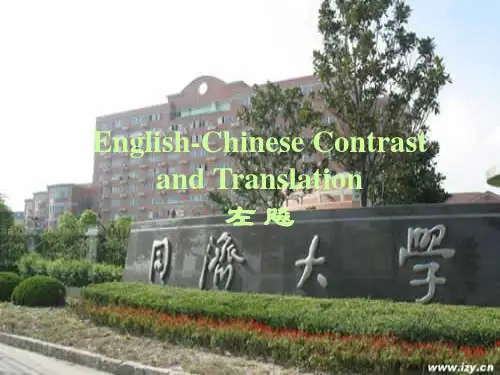
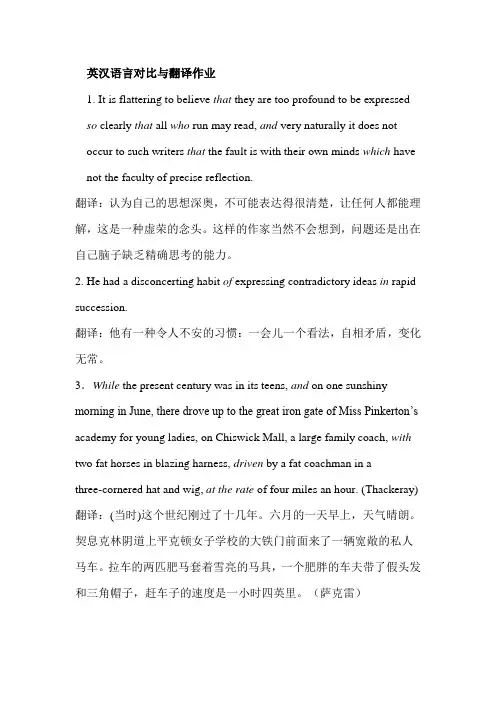
英汉语言对比与翻译作业1. It is flattering to believe that they are too profound to be expressed so clearly that all who run may read, and very naturally it does not occur to such writers that the fault is with their own minds which have not the faculty of precise reflection.翻译:认为自己的思想深奥,不可能表达得很清楚,让任何人都能理解,这是一种虚荣的念头。
这样的作家当然不会想到,问题还是出在自己脑子缺乏精确思考的能力。
2. He had a disconcerting habit of expressing contradictory ideas in rapid succession.翻译:他有一种令人不安的习惯:一会儿一个看法,自相矛盾,变化无常。
3.While the present century was in its teens, and on one sunshiny morning in June, there drove up to the great iron gate of Miss Pinkerton’s academy for young ladies, on Chiswick Mall, a large family coach, with two fat horses in blazing harness, driven by a fat coachman in athree-cornered hat and wig, at the rate of four miles an hour. (Thackeray)翻译:(当时)这个世纪刚过了十几年。
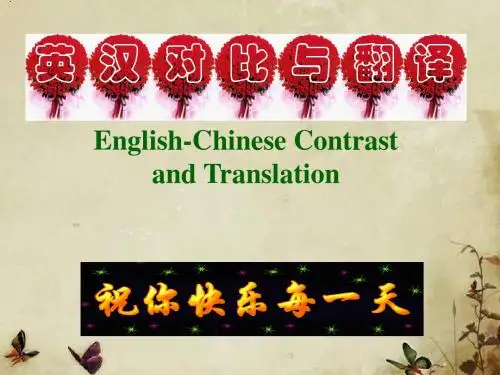
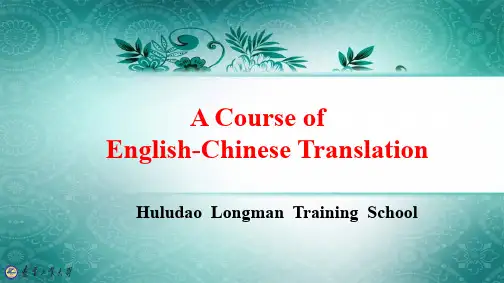
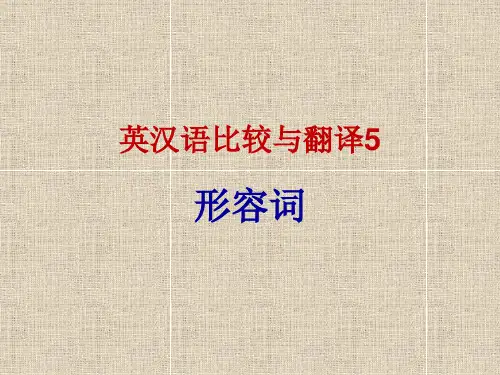

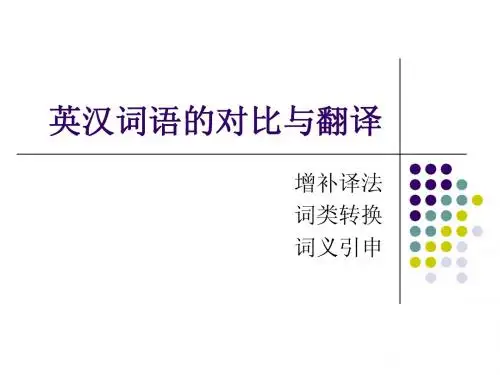
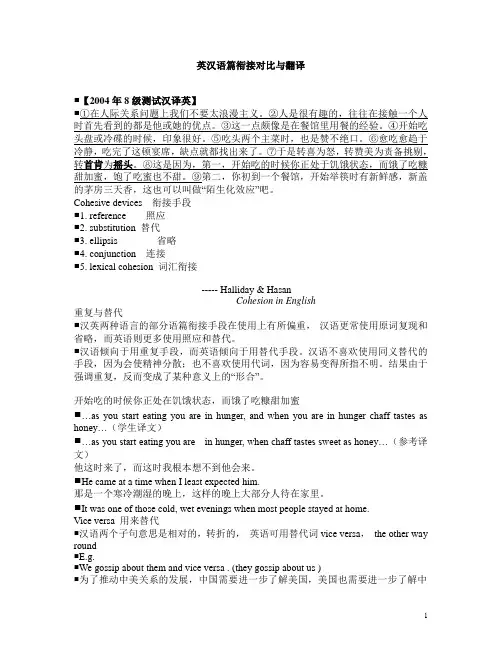
英汉语篇衔接对比与翻译【2004年8级测试汉译英】①在人际关系问题上我们不要太浪漫主义。
②人是很有趣的,往往在接触一个人时首先看到的都是他或她的优点。
③这一点颇像是在餐馆里用餐的经验。
④开始吃头盘或冷碟的时候,印象很好。
⑤吃头两个主菜时,也是赞不绝口。
⑥愈吃愈趋于冷静,吃完了这顿宴席,缺点就都找出来了。
⑦于是转喜为怒,转赞美为责备挑剔,转首肯为摇头。
⑧这是因为,第一,开始吃的时候你正处于饥饿状态,而饿了吃糠甜加蜜,饱了吃蜜也不甜。
⑨第二,你初到一个餐馆,开始举筷时有新鲜感,新盖的茅房三天香,这也可以叫做“陌生化效应”吧。
Cohesive devices 衔接手段1. reference 照应2. substitution 替代3. ellipsis 省略4. conjunction 连接5. lexical cohesion 词汇衔接----- Halliday & HasanCohesion in English重复与替代汉英两种语言的部分语篇衔接手段在使用上有所偏重,汉语更常使用原词复现和省略,而英语则更多使用照应和替代。
汉语倾向于用重复手段,而英语倾向于用替代手段。
汉语不喜欢使用同义替代的手段,因为会使精神分散;也不喜欢使用代词,因为容易变得所指不明。
结果由于强调重复,反而变成了某种意义上的“形合”。
开始吃的时候你正处在饥饿状态,而饿了吃糠甜加蜜…as you start eating you are in hunger, and when you are in hunger chaff tastes as honey…(学生译文)…as you start eating you are in hunger, when chaff tastes sweet as honey…(参考译文)他这时来了,而这时我根本想不到他会来。
He came at a time when I least expected him.那是一个寒冷潮湿的晚上,这样的晚上大部分人待在家里。
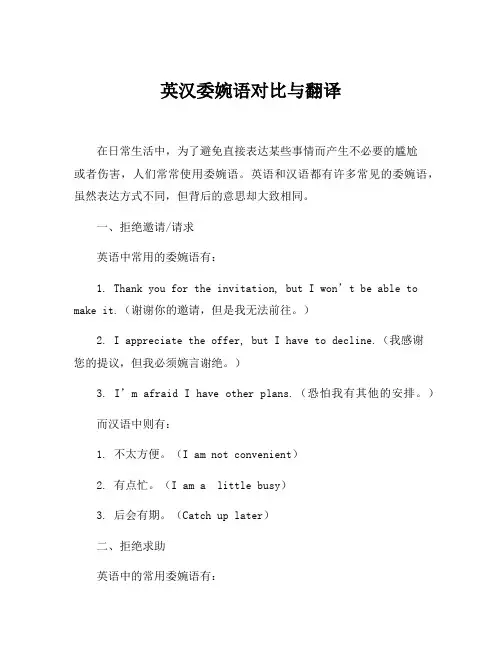
英汉委婉语对比与翻译在日常生活中,为了避免直接表达某些事情而产生不必要的尴尬或者伤害,人们常常使用委婉语。
英语和汉语都有许多常见的委婉语,虽然表达方式不同,但背后的意思却大致相同。
一、拒绝邀请/请求英语中常用的委婉语有:1. Thank you for the invitation, but I won’t be able to make it.(谢谢你的邀请,但是我无法前往。
)2. I appreciate the offer, but I have to decline.(我感谢您的提议,但我必须婉言谢绝。
)3. I’m afraid I have other plans.(恐怕我有其他的安排。
)而汉语中则有:1. 不太方便。
(I am not convenient)2. 有点忙。
(I am a little busy)3. 后会有期。
(Catch up later)二、拒绝求助英语中的常用委婉语有:1. I’d love to help, but unfortunately I’m tied up at the moment.(我很想帮忙,但目前很忙。
)2. I’m sorry, I don’t think I can be of much help in this case.(抱歉,我觉得我对这个事情没有什么帮助。
)3. I appreciate your asking me, but I don’t think I’m the right person to help you.(感谢你向我求助,但我认为我不是合适的人选。
)而汉语中则有:1. 实在抱歉。
(I am really sorry)2. 我没有时间。
(I don't have the time)3. 非常抱歉,我不能帮您。
(I'm terribly sorry, I cannot help you.)三、让对方不要打扰英语中常用的委婉语有:1. I’m sorry, I’m not feeling well, so I need to rest.(抱歉,我不太舒服,需要休息。
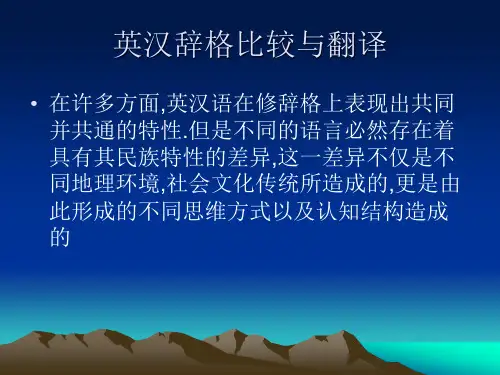

英汉动物词汇文化对比于翻译一、动物词文化语义不同的原因:1.传统习俗东西方传统的巨大差异导致中英文里动物词汇文化意义的差别。
在中国人眼里,喜鹊是吉祥鸟,它的出现预示贵客来监。
但在英语国家里却是唠叨的象征。
中文里的蝙蝠从古到今都象征福气,而英语文化中却与福无关,甚至有邪恶与憎恶之意,像“as crazy as a bat”(疯得像蝙蝠)与“have bats in thebelfry”(异想天开)。
中国传统文化中的鹤象征长寿,所以有“鹤发童颜”与“鹤寿松龄”等。
英文中长寿的象征却是大象。
中文里凤代表吉祥幸福,也代表用来比喻少见的人才与罕见之物,如“凤毛麟角”。
英语中的凤凰则是复活与永生的代表,如“I believe that a phoenix that rises from its ashes will be even more dazzlingly beautiful.”(我始终相信浴火重生的凤凰将会更夺目。
)英汉两个民族在漫长的社会发展中形成了各自不同的文化传统,源远流长。
英汉文化中的神话传说、历史传统以及宗教信仰等在很大程度上造成了动物词文化意象的不同。
例如,凤凰( phoenix) ,依照Br ewer’s Dictionary of Phrase and Fable的说法, 凤凰是传说中的长生鸟,在阿拉伯沙漠上生存了五六百年,临死前衔草木筑巢,在唱完一首挽歌后用翅膀扇火自焚,然后从灰烬中又诞生出一只新凤凰。
于是,西方文化便取凤凰不死的神性,在英语中赋予其“复活”、“再生”的文化意象。
在汉语传统文化中,因凤凰的神异与美丽人们将其视为吉祥如意的象征,人们赋予了它“吉祥、珍贵、美丽”的文化意象,如“龙凤呈祥”喻指婚姻的完美,“凤毛麟角”表示非常珍贵的东西,以“凤姿”来象征女性的优美等。
在一种文化中提到某些动物时往往可以联想到某特征, 而在另一种文化中却联想不到任何特征。
这种例子, 举不胜举。
英汉句法结构对比与翻译
1.主谓结构:英语中主语和谓语动词之间的位置固定,而且一般不允许有其他成分插入;汉语中则允许主谓之间插入状语、宾语等成分,主语通常出现在句首,谓语动词出现在句尾。
英语:He is reading a book.
汉语:他正在看书。
2.宾语结构:英语中宾语通常出现在动词后面,而且一般不允许有其他成分插入;汉语中宾语可以放在动词前面或后面,并且可以有其他成分插入。
英语:She likes to eat apples.
汉语:她喜欢吃苹果。
3.状语结构:英语中状语通常出现在动词后面,表示时间、地点、方式等信息;汉语中状语的位置比较灵活,可以出现在句首、句中或句尾。
英语:He goes to school by bus every day.
汉语:他每天坐公交车去学校。
在进行翻译时,需要根据英语和汉语的句子结构差异进行相应的调整和转换。
具体翻译方法有:
1.主谓结构的翻译:将英语的主语翻译为汉语的主语,谓语动词翻译为汉语的谓语动词。
2.宾语结构的翻译:将英语中的宾语翻译为汉语中的宾语,并根据需要放置在动词前面或后面。
3.状语结构的翻译:将英语中的状语翻译为汉语中的状语,并根据需要放置在句首、句中或句尾。
需要注意的是,不仅要考虑句子结构的差异,还要考虑语言的习惯表达方式和上下文的语境。
对于复杂的句子结构和长篇文章的翻译,还需要进行更加细致的分析和翻译。
LECTURE 1Part 1Native Language Transfer in FL Learning: Interference or Facilitation?外语学习中的母语迁移:干扰还是促进?There are two types of transfer: Negative Transfer and Positive Transfer. Keen awareness of the similarities and differences between the two la nguages can facilitate FL learning.The causes of Interference in Negative Transfer:·analogical use of one’s prior knowledge of the mother tongue母语先知结构的类推运用·scanty knowledge of differences between the two languages对两种语言的差异所知甚少·unconscious falling back on the mother tongue speech habit不自觉地回归母语的言语习惯Examples of Negative Transfer:①Phonological transfer (语音迁移)The sound /n/ does not exist in some Chinese dialects and /l/ serves as a substitute. The writer likes writing at light (night).②Morphological transfer(词形迁移)Neither nouns nor verbs have inflections in Chinese.He only eat two meal a day.③Collocation transfer (搭配迁移)The noun renkou,the Chinese equivalent of …population‟, can have a numerical pre-modifier. Shanghai is said to have thirteen million population.④Syntactical transfer (句型迁移)The verb jianyi,the Chinese equivalent of …suggest‟, can be used in VOC pattern in Chinese. He suggested me to accept this offer.⑤Pragmatic transfer (语用迁移)The negative reply to a compliment is considered in Chinese as modest and courteous.-- Y our English is wonderful.-- No, no. My English is still poor.Part TwoA Contrastive Study of English and Chinese 英汉语对比研究Contrast Between English and ChineseChinese:·Meaning-focused with emphasis on implicit coherence (隐性连贯)·left-extending, heavy-headed like a lion·moving point of sight·bamboo-like sentence structure with different sections linked and yet separated(竹式结构)·T opic-Comment Sentence Structure·Order of linguistic elements: relatively fixed like bamboo-making (制竹)(语序相对固定)English:·Form-focused with emphasis on explicit cohesion(显性联接)·English: right-extending heavy-tailed like a peacock fixed point of sight ·tree-like sentence structure with different parts connected like branches and sub-branches to the trunk line.(树式结构)·Subject-Predicate Sentence Structure·Order of linguistic elements: relatively flexible like block-building (积木)(语序相对灵活)Example:Chinese: bamboo-like sentence structure (竹式结构)The chunks of a sentence seem to be connected and yet separated, like sections of a bamboo linked by the joints and yet relatively independent and self-contained.例:从前这里有一个渔村,村里住着十户人家,这十户人家全靠打鱼、种地为生,生活艰苦,但很安宁。
English: tree-like sentence structure (树式结构)tree-like sentence structure with different parts connected like branches and sub-branches to the trunk line.Eg: As a nation of gifted people who comprise about one-fourth of the total population of the earth, China plays in world affairs a role that can only grow more important in the years ahead.English 英语Chinese 汉语Form-focused 形态型Meaning-focused 语义型Right-extending 孔雀型Left-extending 狮子型Sight-moving 视点流动Sight-fixed 视点固定Tree-like 树型结构Bamboo-like 竹型结构Subject-prominent 主语突出T opic-prominent 主题突出Order-flexible 语序相对灵活Order-fixed 语序相对固定English 英语Chinese 汉语Impersonal 物称Personal 人称Passive 被动Active 主动Static 静态Dynamic 动态Complex 繁复Simple 简单Abstract 抽象Concrete 具体Hypotactic 形合Paratactic 意合Plain and factual 平实Rhythmic and symmetrical 韵律LECTURE 21、英语的主谓提挈机制-6个基本句型句型1:S (主语) +V(谓语)Eg: Li Ming works very hard.句型2:S (主语) +Link. V(系动词) +Predicate(表语)Eg: This kind of food tastes delicious.句型3:S (主语) +V (谓语) +O (宾语)Eg: He took his bag and left.句型4:S (主语)+V (谓语)+Indirect object+Direct objectHer father bought her a dictionary as a birthday present.句型5:S (主语)+V (动词)+O (宾语)+C (补语)You should keep the room clean and tidy.句型6:There be + S+ elseThere are two girls and a boy running on the playground.2、汉语的“话题”及界定(主语后+是不是)3、汉英翻译中的主语转换问题①对应Equivalence苏轼是位才华横溢的文学家。
Su Shi was a writer with superb talent.②转换Shift词类转换式主语转移我们的自然科学比较落后,要努力向外国学习。
In natural sciences, we are rather backward and here, we should make a special effort to learn from foreign countries.推导式主语转移我的法语看报很吃力,你呢?I can’t re ad newspaper in French without difficulty, how about you?反逆式主语转移一胎生了三个女儿。
Three daughters were born at one birth.③补充Supplement话题式主语句今天他要去看病。
He is going to see the doctor today.零位主语句隐含主语句The show begins now.坐享其成3、推导主语的规范:①原句的动词常常是我们展开推导的出发点和根据。
一般说来,它可以给我们提供准确的、边切的推导线索,推导出与之搭配的施动者。
②原句的总体意义是我们展开推导的最重要的依据,特别是在汉语原句中没有谓语动词时,全局的总体意义就是最重要的根据。
③推出补加主语时,常常必须把握住原语材料的关涉对象,即文章为谁而写、议论为谁而发、内容牵涉到谁,等等。
主语转移的一般规范:●必须紧扣原意,只要不违背全句的总体意义,选择可灵活变通,不拘一格.●必须密切顾及英语的习惯表达法。